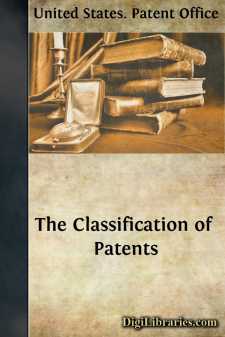Categories
- Antiques & Collectibles 13
- Architecture 36
- Art 48
- Bibles 22
- Biography & Autobiography 813
- Body, Mind & Spirit 142
- Business & Economics 28
- Children's Books 15
- Children's Fiction 12
- Computers 4
- Cooking 94
- Crafts & Hobbies 4
- Drama 346
- Education 46
- Family & Relationships 57
- Fiction 11828
- Games 19
- Gardening 17
- Health & Fitness 34
- History 1377
- House & Home 1
- Humor 147
- Juvenile Fiction 1873
- Juvenile Nonfiction 202
- Language Arts & Disciplines 88
- Law 16
- Literary Collections 686
- Literary Criticism 179
- Mathematics 13
- Medical 41
- Music 40
- Nature 179
- Non-Classifiable 1768
- Performing Arts 7
- Periodicals 1453
- Philosophy 64
- Photography 2
- Poetry 896
- Political Science 203
- Psychology 42
- Reference 154
- Religion 513
- Science 126
- Self-Help 84
- Social Science 81
- Sports & Recreation 34
- Study Aids 3
- Technology & Engineering 59
- Transportation 23
- Travel 463
- True Crime 29
The Classification of Patents
Categories:
Description:
Excerpt
The facilitation and abbreviation of mental labor is at the bottom of all mental progress. The reasoning faculties of Newton were not different in qualitative character from those of a ploughman; the difference lay in the extent to which they were exerted and the number of facts which could be treated. Every thinking being generalizes more or less, but it is the depth and extent of his generalizations which distinguish the philosopher. Now it is the exertion of the classifying and generalizing powers which thus enables the intellect of man to cope in some degree with the infinite number and variety of natural phenomena and objects. (Jevons, Principles of Science.)
PAST CLASSIFICATIONS OF UNITED STATES PATENT OFFICE.
As under the patent laws the people of the United States assume all the risks in granting a patent for any means of the "useful arts," a classification that will facilitate a judgment respecting the patentability of any means presented to the Patent Office is of peculiar moment. The enormous extent, diversity, and refinement of the useful arts preclude the formation of a judgment on novelty within a reasonable time, unless the necessary comparisons with known processes and instruments have been previously made along the lines that searches must follow and the results of such comparisons made available in a classification. The vast majority of available disclosures of the arts occur in patents. Hence the Patent Office classification must be adjusted in the main to the analysis, diagnosis, and orderly arrangement of the disclosures of patents.
For more than 80 years United States patents have been classified. The first published classification, promulgated in 1830, comprised 6,170 patents, divided into 16 classes. The change from a registration to an examination system in 1836 instigated a new classification in 22 classes, including 9,800 patents. The next came in 1868 with 36 classes, including about 75,000 patents. On March 1, 1872, a revised classification was adopted, comprising 145 classes, including 131,000 patents. This classification is said to have been planned by Dr. Edward H. Knight. The placing of the patents in accordance with the schedule of classes is said to have been done by the several examiners. The class arrangement was purely alphabetical by class titles, and the number designations followed the alphabetical order. The names of things to be found in the several classes were arranged alphabetically under each class title. No attempt was made to bring the titles of allied materials into juxtaposition or to effect other definite arrangement with reference to subject matter in the printed schedules. A consolidated name index supplemented the list of names by classes.
This classification of 1872 is in part the classification that now exists, many of the same class numbers and titles being still in use. Examiners were apparently permitted to make changes in classification to suit their convenience without notice until 1877. In that year a revision of the published schedule was made by a committee, resulting in the addition of 13 new classes, and examiners were ordered to transfer patents in accordance with the new titles. The first classification published with distinct subclasses appeared in 1880. From that time until 1898 the classification grew by addition and subdivision of classes to suit the ends of individual examiners or in response to supposed exigencies of the work where one division was thought to be overloaded and another underloaded, and the alphabetical arrangement of subclasses under each class has succeeded the alphabetical list of names. The arbitrary correspondence originally established between the alphabetical order of class titles and the numerical order was destroyed as soon as expansion of the classification began....


